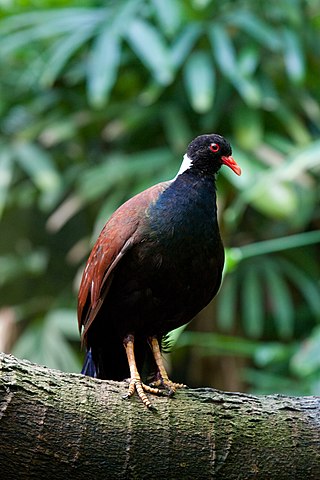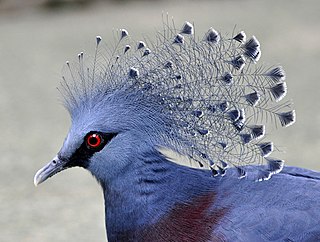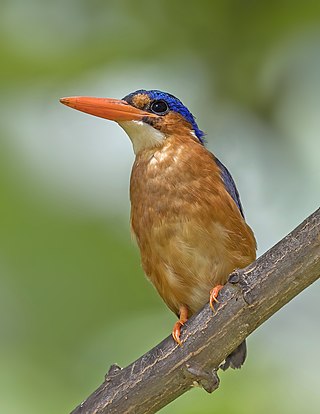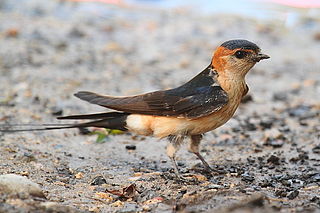
Count Adelardo Tommaso Salvadori Paleotti was an Italian zoologist and ornithologist.

The pheasant pigeon is a species of large terrestrial pigeon. It is the only species of the monotypic genus Otidiphaps. The pheasant pigeon is found in the primary rainforests of New Guinea and nearby islands. It ranges primarily over hilly and lower mountain areas, but can also be found in lowlands.

The crowned pigeons (Goura) is a genus of birds in the family Columbidae. It contains four large species of pigeon that are endemic to the island of New Guinea and a few surrounding islands. The species are extremely similar to each other in appearance, and occupy different regions of New Guinea. The genus was introduced by the English naturalist James Francis Stephens in 1819.

The western crowned pigeon, also known as the common crowned pigeon or blue crowned pigeon, is a large, blue-grey pigeon with blue lacy crests over the head and dark blue mask feathers around its eyes. Both sexes are almost similar but males are often larger than females. It is on average 70 cm (28 in) long and weighs 2.1 kg (4.6 lbs).

Scheepmaker's crowned pigeon is a large, terrestrial pigeon confined to the lowland forests of south eastern New Guinea. It has a bluish-grey plumage with elaborate blue lacy crests, red iris and very deep maroon breast. Both sexes have a similar appearance. It is on average 70 cm (28 in) long and weighs 2,250 grams (5 lbs), making this the second largest living pigeon species behind the Victoria crowned pigeon.

The fawn-breasted waxbill is a common species of estrildid finch found in central Africa. It has an estimated global extent of occurrence of 1,800,000 km2. Estrilda paludicola, E. ochrogaster and E. poliopareia have been lumped into E. paludicola.

The Fly River grassbird is a species of Old World warbler in the family Locustellidae. It is found in Indonesia and Papua New Guinea. Its natural habitats are freshwater marshes and lakes. It is threatened by habitat loss.

The Papuan mountain pigeon is a species of bird in the pigeon family, Columbidae. It is found in the Bacan Islands, New Guinea, the D'Entrecasteaux Islands, and the Bismarck Archipelago, where it inhabits primary forest, montane forest, and lowlands. It is a medium-sized species of pigeon, being 33–36 cm (13–14 in) long and weighing 259 g (9.1 oz) on average. Adult males have slate-grey upperparts, chestnut-maroon throats and bellies, whitish breasts, and a pale grey terminal tail band. The lores and orbital region are bright red. Females are similar, but have grayish breasts and grey edges to the throat feathers.

Mountain pigeons are four species of birds in the genus Gymnophaps in the pigeon family Columbidae. They are found on islands in eastern Indonesia and Melanesia, where they inhabit hill and montane forest. Medium-sized pigeons with long tails and wings, they are 33–38.5 cm (13.0–15.2 in) long and weigh 259–385 g (9.1–13.6 oz). They mostly have dull grey, white, or chestnut-brown plumage, their most distinctive feature being bright red skin around the eyes. Males and females mostly look alike, but the Papuan and pale mountain pigeons show slight sexual dimorphism. Mountain pigeons are very social and are usually seen in flocks of 10–40 birds, although some species can form flocks of more than 100 individuals. They are generally quiet and do not make many vocalisations apart from a distinctive whooshing noise while leaving their high-altitude roosts to feed in the morning.

The ornate fruit dove is a species of bird in the family Columbidae. It is found in New Guinea. Its natural habitats are subtropical or tropical moist lowland forest and subtropical or tropical moist montane forest.
The pied cuckoo-dove is a species of bird in the pigeon family, Columbidae. First described by English zoologist Philip Sclater in 1877, it is endemic to the Bismarck Archipelago, where it mainly inhabits lowland and hill forests at elevations of up to 1,000 m (3,300 ft). It is a large, distinctive pigeon, with a length of 40–46 cm (16–18 in) and a weight of 279–325 g (9.8–11.5 oz). Adults are mainly black and white, with a whitish heads and underparts, and black wings, tails, and upperparts. Both sexes look alike. Juveniles are mainly sooty-grey in colour.

The crested cuckoo-dove is a species of bird in the pigeon family, Columbidae. First described by English zoologist John Gould in 1859, it is endemic to the Solomon Islands archipelago, where it mainly inhabits hill forests at elevations of 500–900 m (1,600–3,000 ft). It is a large and robust pigeon, with a length of 40–41 cm (16–16 in) and a distinctive pale purplish-grey crest. Adults are mainly bluish-grey, with a pale greyish-buff throat, blackish tail, and yellow-tipped reddish bill. Both sexes look alike. Juveniles lack the crest, have darker heads, and have duller wings.

The São Tomé kingfisher is a bird in the family Alcedinidae. It is endemic to São Tomé, an island off the west coast of Africa in the Gulf of Guinea and was first described by the Italian ornithologist Tommaso Salvadori in 1902 under the binomial name Corythornis thomensis. A molecular phylogenetic study published in 2008 showed that the São Tomé kingfisher is a subspecies of the malachite kingfisher.

The white-fronted tit is a species of bird in the family Paridae. It is endemic to the Philippines found in the islands of Luzon and Mindanao. Its natural habitat is tropical moist lowland forests. It is threatened by habitat loss.

The capuchin babbler is a species of bird in the family Leiothrichidae.

The black-throated robin is a species of passerine bird in the Australisian robin family Petroicidae. It is found on the island of New Guinea. Its natural habitat is subtropical or tropical moist montane forests at 1,150–2,750 metres above sea-level.

The banded yellow robin or olive-yellow robin is a species of bird in the Australasian robin family Petroicidae that is found in New Guinea. It is the only species in the genus Gennaeodryas. Its natural habitats are subtropical or tropical moist lowland forest and subtropical or tropical moist montane forest. It is threatened by habitat loss. It has a high mortality rate due to its inability to traverse across a matrix.

Cecropis is a genus of large swallows found in Africa and tropical Asia. The red-rumped swallow's range also extends into southern Europe, and into Australia. This genus is frequently subsumed into the larger genus Hirundo.

The grey-rumped swiftlet or grey-rumped swiftlet, is a small bird in the swift family Apodidae. It is endemic to some islands in the Philippines.

Birds described in 1876 include the tooth-billed bowerbird, Heuglin's gull, Chinese white-browed rosefinch, Sclater's crowned pigeon, Pohnpei flycatcher, mountain myzomela, streak-headed honeyeater and Maxwell's black weaver.


















